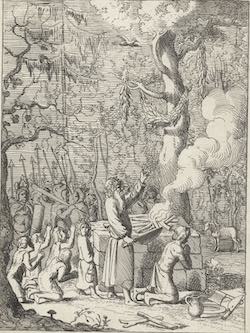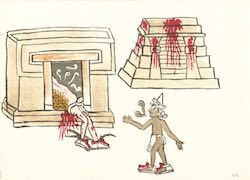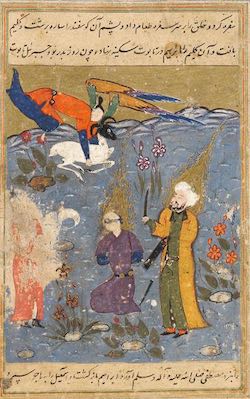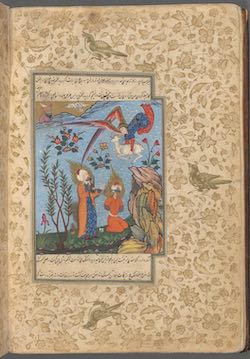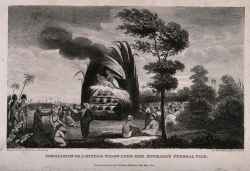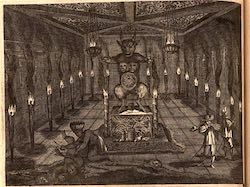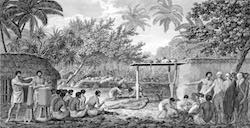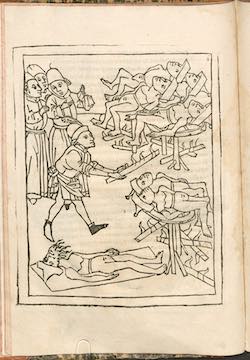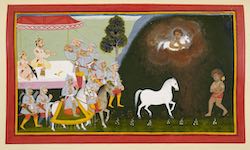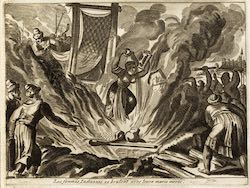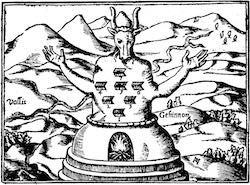Topic: 2. Sacrifice and religion: Comparisons, Antiquarians, Anthropology (16th-18th Century)
Religious sacrifices across various cultures and contexts sparked widespread interest in Early Modern Europe. As Christianity expanded into regions inhabited by "infidels" and "pagans", Europeans encountered a diverse array of sacrificial customs, ranging from the Sati rituals in India to the Aztec sacrifices in the Americas. This cross-cultural exposure captivated a wide audience, including theologians, philosophers, political thinkers, antiquarians, orientalists, missionaries, poets, artists, and even the general public. These encounters broadened the European understanding of sacrifice and led to a critical reassessment of classical and biblical sacrificial rites. This section includes:
- Sources: A selection of early modern printed materials, which include descriptions of the Americas, Asia, and Africa, alongside antiquarian and philological studies on religious sacrifice in classical antiquity and beyond. It also presents early modern works of ethnological observations and the first attempts to compare different sacrificial practices in various traditions and contexts, laying the groundwork for disciplines like the history of religions and anthropology.
- Iconographic Representations: A rich collection of images from the 16th to 18th centuries, illustrating a range of sacrificial rituals and practices as seen in different cultural and geographical contexts.
- Related Bibliography: An extensive bibliography spanning scholarly works from the 19th to 21st centuries, providing contemporary analyses and interpretations of these early studies and observations.
Human sacrifice in the forest (1660)
from: Johan Picardt, Korte beschryvinge van eenige vergetene en verborgene antiquiteten ... in het antiquiteet-rijcke landschap Drenth, Tymon Houthaak, Amsterdam, 1660, fol. 67
Rijksmuseum, Amsterdam
Human sacrifice. Native American plunges a knife into another's chest. Two bodies hang, a statue of an idol or devil on a pillar stands at left (1554)
from: Pedro Cieza de León, Parte primera de la chronica del Peru, Antwerp, Iuan Steelsio, 1554, pag. 48
Humans Sacrificed in the Fire and on the Pyramid [1526 - 1550]
from: Codex Magliabecchiano, c. 40r
Biblioteca Nazionale di Firenze, Florence
Ibrahim Preparing to Sacrifice Isaac (17th)
from: Ishaq b. Ibrahim al-Nayshaburi, Qisas al-Anbiya (Tales of the Prophets), ms, fol. 43 Turkey
Harvard Art Museums/Arthur M. Sackler Museum, The Edwin Binney, 3rd Collection of Turkish Art at the Harvard Art Museums Object Number 1985.275.43
Ibrâhîm [Abraham] Sacrifice of his Son Ismâ'îl (1577)
Public Library, Spencer Collection, Persian, ms. 1, New York
Ifigenia Treuspel (1715)
from: Racine. Jean. Ifigenia in Aulis, treurspel, Amsterdam, Jacob Lescailje, 1715, Frontespiece
Rijksmuseum Amsterdam
Immolation of a Hindoo Widow (1814)
from: Lester. The Gallery of Nature and Art, 1814
London, Wellcome Collection
In the palace, Rāvaṇa and his remaining brothers and sons are bowed down by grief and Rāvaṇa wonders how he can ever be victorious in this conflict, when so many demon champions have been slain. Another son, Indrajit, boasts that he will overcome Rāma and Lakṣmaṇa and sets out in his chariot, surrounded by other demons on elephants, horses and in chariots. In a separate chamber (the text actually says on the battlefield), he prepares offerings, seizing a young black goat by the neck, to the god of Fire in order to conjure up his most magical weapons and to make himself invisible. (ca 1653)
from: Ramayana [ms Add. 15297(1), fol. 97]
British Library, London [from Udaipur]
Indian Woman Burning Alive (18th century)
http://www.columbia.edu/itc/mealac/pritchett/00routesdata/1800_1899/hinduism/sati/sati.html
Interior of a temple with an idol which has horns and faces on its chest. Also includes torches and lamps. Includes a scene of sacrifice, bones or skeleton, knife, and European soldiers. (1671)
from: Arnoldus Montanus, De Nieuwe en Onbekende Weereld, Amsterdam, Jacob Meurs, 1671, p. 82
John Carter Brown Library
James Cook, English Navigator, witnessing Human Sacrifice in Taihiti (Otaheite) 1773ca. [1773]
from: Cook, James. Voyages, [Woodbridgen?], [Smith?], 1815
Jews put to the flames (1475)
from: Historie von Simon zu Trient [Bayerische StaatsBibliothek, 2 Inc.s.a. 62#Beibd], fol. 11v
Bayerische Staatsbibliothek, Munich
King Sagara performs a sacrifice (1712)
from: Ramayana, Bala Kanda
British Library, Add. 15295, f.105
Les femmes Indiennes se brulent (1725)
from: van der Aa, P. La galerie agreable du monde. Tome premier des Indes Orientales, Leiden, c. 1725
http://www.columbia.edu/itc/mealac/pritchett/00routesdata/1800_1899/hinduism/sati/sati.html
Les veuves du Cormandel (1725)
from: van der Aa, P. La galerie agreable du monde. Tome premier des Indes Orientales, Leiden, c. 1725
http://www.columbia.edu/itc/mealac/pritchett/00routesdata/1800_1899/hinduism/sati/sati.html
Mictlāntēcutli God with Sacrificial Knife [1476 - 1500]
from: Codex Borgia, c. 18r
Biblioteca Apostolica Vaticana, Vatican
Miniature llama figurine, wrought in hammered gold, probably deposited as an offering to the mountain gods, accompanying a human sacrifice (1500-1532)
from: Peru
The British Museum, London
Moloch (1652 - 1654)
from: Athanasius Kircher, Oedipus Aegyptiacus, V. Mascardi, Roma,1652-1654

